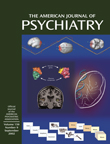Rhabdomyolysis With Simvastatin and Nefazodone
To the Editor: Pharmacotherapy for depression and hypercholesterolemia may result in potentially fatal drug-drug interactions involving the cytochrome P-450 (CYP-450) system. Hepatic hydroxymethyl glutaryl coenzyme (HMG-CoA) reductase inhibitors (simvastatin, atorvastatin, and lovastatin) are metabolized by the 3A4 isoenzyme, while ketoconazole, fluvoxamine, nefazodone, and even grapefruit juice inhibit it (1). In healthy adults, co-administration of simvastatin and nefazodone resulted in an approximately 20-fold increase in simvastatin and simvastatin acid (2). It is likely that the risk of rhabdomyolysis increases with high levels of HMG-CoA reductase activity in plasma (2). We report a case of such an interaction that followed the addition of nefazodone treatment for a patient receiving simvastatin. To our knowledge, this is only the second report of this probable interaction (3).
Mr. A, a 72-year-old Hispanic man with recurrent depression, anxiety, insulin-dependent diabetes mellitus, hypertension, and hyperlipidemia, was referred for severe depression and anxiety. His medications upon his visit to the psychiatrist were paroxetine, lorazepam, mirtazapine, risperidone, zolpidem, insulin, metformin, and simvastatin. Multiple previous antidepressant trials of sufficient dose and duration had failed to relieve his symptoms. His only significant laboratory test abnormality was a glucose level of 40 mg/dl; no subsequent glucose levels had been found to be lower than 74 mg/dl. The psychiatrist discontinued paroxetine, mirtazapine, lorazepam, and risperidone and initiated nefazodone, 100 mg b.i.d., clonazepam, and trazodone. Four weeks later, the nefazodone dose was increased to 300 mg at bedtime.
Two weeks later, Mr. A was admitted to the medical service with a 3-day history of generalized weakness, a cough, a fever, and a provisional diagnosis of viral syndrome. After admission, the results of laboratory tests included a creatinine kinase level of 10,555 U/liter, an aspartate aminotransferase level of 72 U/liter, a lactose dehydrogenase level of 350 U/liter, and urine containing moderate blood, five to six red blood cells per high-power field, and one to two WBCs per high-power field. Mr. A’s blood urea nitrogen, creatinine, and alanine aminotransferase levels remained within normal limits; his serum myoglobin level was not tested. Nefazodone was discontinued, Mr. A was hydrated intravenously, and 2 days later he was discharged with a creatinine kinase level of 3869 U/liter. He was feeling less weak and afebrile. One week later, his weakness had nearly resolved (his creatinine kinase level was 261 U/liter). He has continued taking simvastatin and venlafaxine without complications.
Nefazodone, a potent inhibitor of the CYP 3A4 system, should be used with caution in combination with 3A4 substrates, including simvastatin. We believe this patient’s rhabdomyolysis was likely a result of this interaction. Although the rhabdomyolysis resolved with hydration and nefazodone discontinuation, renal failure may have occurred if clinical attention had not been sought (4). With an increasing rate of statin prescription (5) and nefazodone’s possible association with liver failure (2), even more attention should be paid to possible complications related to these agents. Given this information, nefazodone may not be the best first-line antidepressant therapy for patients taking statins metabolized by the 3A4 system. When patients are given this drug combination, the symptoms of rhabdomyolysis should be carefully reviewed with them. Psychiatrists should be vigilant about reviewing medication lists for potentially serious drug interactions.
1. Ketter TA, Flockhart DA, Post RM, Denicoff K, Pazzaglia PJ, Marangell LB, George MS, Callahan AM: The emerging role of cytochrome P450 3A in psychopharmacology. J Clin Psychopharmacol 1995; 15:387-398Crossref, Medline, Google Scholar
2. Physicians’ Desk Reference. Montvale, NJ, Medical Economics, 2002, pp 1104-1108Google Scholar
3. Jacobson RH, Wang P, Glueck CJ: Myositis and rhabdomyolysis associated with concurrent use of simvastatin and nefazodone (letter). JAMA 1997; 277:296-297Crossref, Medline, Google Scholar
4. Visweswaran P, Guntupalli J: Rhabdomyolysis. Crit Care Clin 1999; 15:415-428, ix-xCrossref, Medline, Google Scholar
5. Packham C, Pearson J, Robinson J, Gray D: Use of statins in general practices, 1996-8: cross sectional study. Br Med J 2000; 320:1583-1584Crossref, Medline, Google Scholar



